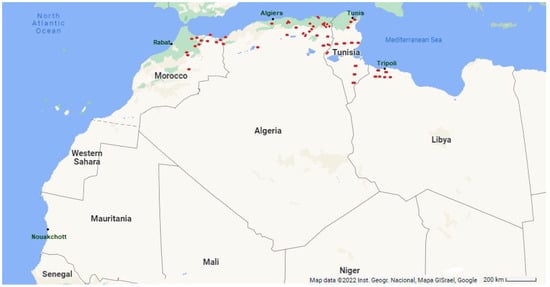Your browser does not fully support modern features. Please upgrade for a smoother experience.
Please note this is a comparison between Version 1 by Luís R. Silva and Version 3 by Camila Xu.
The word Thymus comes from the Greek “thyo”, which means “offering” (to be burnt) and “perfume” because of the pleasant smell that the plant gives off naturally when burnt. T. algeriensis Boiss. and Reut. are classified in section Hyphodromi (A. Kerner) Haläcsy and subsection Subbracteati (Klokov) Jalas. It belongs to the order Lamiale, subfamily Nepetoideae, and tribe Menthae.
- Thymus algeriensis
- distribution
- botanical aspects
1. Thymus Genera: An Overview
The word Thymus comes from the Greek “thyo”, which means “offering” (to be burnt) and “perfume” because of the pleasant smell that the plant gives off naturally when burnt [1][2][64,65]. In ancient times, the Sumerians and Egyptians used it for embalming their dead (the mummification process). The Romans burned thyme to purify the air and keep pests away [3][4][66,67]. The name “Thyme” comes from the Greek word “Thymos” [5][68], meaning smell. In the Azores, Madeira and the western part of the Iberian Peninsula, Thyme has the Portuguese names “tomentelo” or “tormentelo”, “tomelo do pais”, “tomentelo do pais” or “tomilho” [2][65]. In the mountains of Ethiopia, it is known as “rausi”. Moreover, the African northwest has the following several Arabic vernacular names: “Djertil”, “Hamzoucha”, “Mezouqach”, and “Khieta”, and Berber names such as “Azoukni”, “Tazuknite”, “Rebba”, “Djouchchen”, and “Touchna” [6][69]. In Morocco, it is also called “azukenni” [2][65].
The genus Thymus, described by Carl Linnaeus in Species Plantarum, belongs to the monophyletic group of the subfamily Nepetoideae Kostel, the tribe Mentheae Dumort and the subtribe Menthinae Endl [7][8][3,70]. The species can be sub-shrubs or shrubs, often herbaceous above, usually gynodioic and aromatic. They grow spontaneously on dry, rocky slopes and in scrubland. The stems of species are generally ± quadrangular, hairy all round, on two opposite sides, or only on the corners. The leaves are small, entire, and frequently revolute and form compact, highly branched clumps that rise to about 20 cm above the ground [9][45]. They have inflorescences of whorls forming a terminal, condensed, often spiciform or interrupted thyrse [10][46]. These characteristics can have a high degree of polymorphism, demonstrating the complexity of the genus Thymus from a taxonomic and systematic point of view. Indeed, this hybridization has been observed between species belonging to different sections and between species with varying ploidy levels, resulting in different chemical compositions [2][11][65,71]. Eight sections can be distinguished in the genus from a taxonomic and geographical point of view, as follows: Micantes, Mastichina, Piperella, Teucrioides, Pseudothymbra, Thymus, Hyphodromi, and Serpyllum. Five of them (sections Micantes, Mastichina, Piperella, Pseudothymbra, and Teucrioides) are endemic to the West Mediterranean area (Iberian Peninsula, Northwest Africa) [12][72].
2. Thymus algeriensis Boiss. and Reut.
2.1. Distribution
The medicinal properties of Thymus species have been investigated in numerous scientific studies, including in vitro et in vivo experiments. The results reveal that they have a unique combination of beneficial functions due to the Mediterranean climate [13][14][15][73,74,75]. In this geographical area, the western Mediterranean, under the influence of the Atlantic Ocean, the climatic conditions are favorable for thyme vegetation. Therefore, they are mainly found on the Mediterranean coast [16][76]. Thymus species are sun-loving, heliophilous plants, a fact that reflects the ecology of the genus. Thymus plants frequently live on rocks or stones, and the soil must be well-drained [8][70]. They need very different substrates. T. algeriensis usually lives on calcareous soils, characteristic of the Maghreb [17][77]. The Algerian species are found in the eastern Tell, in the bedrock areas, and on the high mountain plateaus up to the border of the pre-Sahara Tassili [18][19][43,78]. They are mainly present in subhumid and arid zones from the North-East of Algeria to the Tunisian border [9][45]; a few isolated individuals occur in Mascara province and from the Oran region to the Moroccan borders (Figure 1).
2.2. Systematic Classification and Botanical Aspects
According to Morales [2][65], T. algeriensis Boiss. and Reut. are classified in section Hyphodromi (A. Kerner) Haläcsy and subsection Subbracteati (Klokov) Jalas [21][22][80,81]. It belongs to the order Lamiale, subfamily Nepetoideae, and tribe Menthae (Figure 2).
